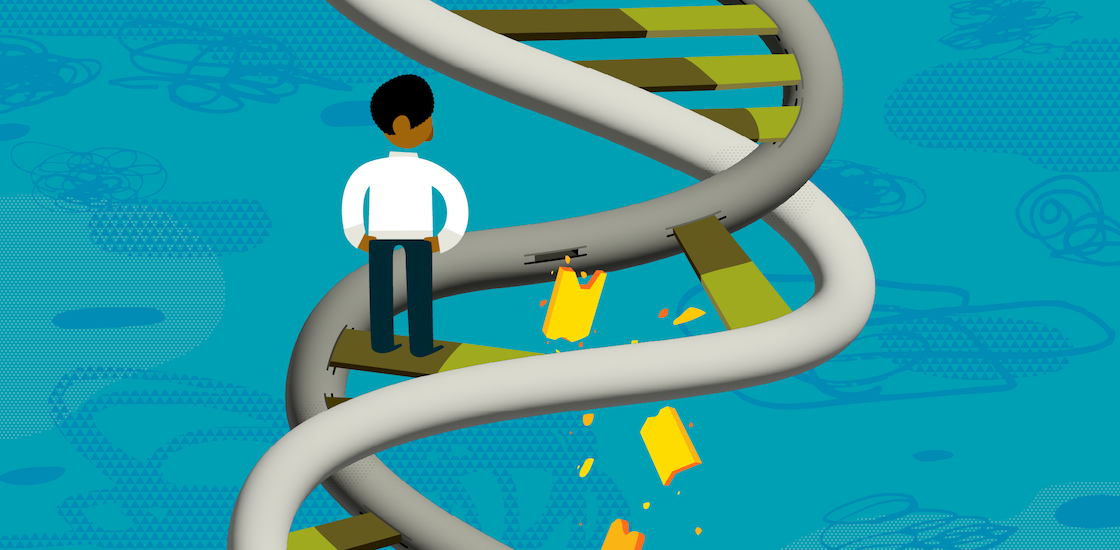People with mutations in the PAX5 gene have a distinct neurodevelopmental syndrome characterized by a range of traits, including developmental delay, intellectual disability, seizures and autism, according to a new study of 16 children and young adults.
Until now, genetic testing did not give people with PAX5 mutations clear answers about their development, says lead investigator Daryl Scott, associate professor of molecular and human genetics at Baylor College of Medicine in Houston, Texas. But “whenever we are able to identify a molecular cause, it informs our medical decision-making and makes us better able to help these children get the medical care that they need.”
Mutations in PAX5 were linked to autism in a large sequencing study in 2014, and scientists’ confidence in this link rose to 90 percent after another sequencing study in 2019. The new work, which appeared in January in Human Mutation, is the first to characterize the clinical traits of people with mutations in the gene.
PAX5 encodes a transcription factor important for embryonic brain development. Most mice missing both copies of the gene in all their cells die at birth, show severe undergrowth and have brain structure alterations; mice missing one copy in all of their cells just have minor brain structure changes, according to a 1994 study. And mice missing the gene only in inhibitory neurons, a later study revealed, have enlarged fluid-filled spaces in their brains, a physical characteristic that is associated with neurodevelopmental conditions.
These studies supported the idea that PAX5 variants might contribute to neurodevelopmental or psychiatric conditions, says Uwe Rudolph, professor of comparative biosciences at the University of Illinois at Champaign-Urbana, who led the study on inhibitory neurons but was not involved in the new work. But they did not enable researchers to draw firm conclusions about the gene’s role in people, Rudolph says.
T
he new case series began with one person Scott saw in his clinic, who had autism, intellectual disability and developmental delay. Genetic testing showed that the individual also had a mutation in PAX5 that, based on family history, seemed to be inherited. Scott referenced the genetic database gnomAD and concluded that the person’s traits probably reflected a ‘loss-of-function’ mutation that disabled one copy of the gene, resulting in lower levels of the PAX5 protein.Scott started looking for others with PAX5 mutations and identified 15 more people aged 20 months to 24 years via GeneMatcher, a site that connects clinicians to individuals with rare mutations who have agreed to share their data. Seven of the participants’ mutations are not found in their parents’ genetic testing results, suggesting that the mutations are ‘de novo,’ or arose spontaneously; two other participants inherited their mutations from a parent. For the remaining seven participants, parental DNA samples were not available.
Among the 16 people in Scott’s case series, 11 have autism, 11 have developmental delay and 9 have intellectual disability. Four participants have documented histories of seizures.
The relationship between genetics and clinical characteristics shown in this study is “interesting and well curated,” says Joon-Yong An, assistant professor of biosystem and biomedical science at Korea University in Seoul, who was not involved in the work. Based on single-gene studies like this one, “clinicians can further evaluate additional clinical phenotypes from individuals having the same affected gene,” he says, as well as track which conditions may arise over time in people with the mutation.
Two participants have sensorineural hearing loss, but overall, few have atypical traits beyond developmental delay, autism or intellectual disability. This result matches those seen in mice missing one copy of PAX5, Rudolph says.
This lack is important to note because many doctors do not think of ordering genetic testing for people who just have one or more of these neurodevelopmental conditions and no other medical problems, Scott says. “We can find genes for kids who appear to have non-syndromic neurodevelopmental problems.”
Scott and his team do not have funding to follow up on this work, but plan to publish more information once they have collected data on additional people. As clinicians, they expect to continue connecting with individuals who have PAX5 mutations, he says. “As soon as one of these papers is published, people start to call.”





